#Node JS server hosting
Explore tagged Tumblr posts
Text
12/10/2023 || Day 96
I spent 4 hours today building a small program that's essentially a set of flashcards for the words I'm learning in my ASL class. I wanted to simply create a set of flashcards with Quizlet, but apparently the ability to add an image to a card is behind a paywall and I don't want to pay for that, so I decided I'll just create my own little flashcard system. The teacher writes words on the board during the class, and after class we're allowed to take pictures. The thing is, I'm remembering the sign for the corresponding word mostly by where it's written on the board and what other words it's grouped with, rather than remembering the sign for the word directly.
So, I built a little program that'll let me input words into an array, and I can ask the program to give me a random word in that array, and it worked! But then came the harder part; where do I store the data? I learned that you cannot write to a file from the frontend, so having a frontend json file will be no good, and I didn't want to store it in local storage because what if I accidentally delete my local storage? It would be a huge pain to write 100+ words and links to their signs over and over, so after some googling I learned that I'd need a backend so I can write to and append to a json file using Node js. Honestly, that's a little annoying because now I have to have a server running, but that's the only way I can think of to store data. I'm also planning on adding a feature where I can search for a specific word in my little database and it will give me the link to a video or gif of someone signing that word. But first, I gotta find those gifs/videos/pages and add them to the database.
This is also a really private project, and will only be used for personal use to remember ASL, so this won't be posted or hosted anywhere other than my local computer. The most obvious reason is because there are resources made by Deaf people that should be sought out for first. I'm personally just using this program so I don't have to google "ASL sign for XYZ" every time I forget how to sign something
14 notes
·
View notes
Text
JavaScript Frameworks
Step 1) Polyfill
Most JS frameworks started from a need to create polyfills. A Polyfill is a js script that add features to JavaScript that you expect to be standard across all web browsers. Before the modern era; browsers lacked standardization for many different features between HTML/JS/and CSS (and still do a bit if you're on the bleeding edge of the W3 standards)
Polyfill was how you ensured certain functions were available AND worked the same between browsers.
JQuery is an early Polyfill tool with a lot of extra features added that makes JS quicker and easier to type, and is still in use in most every website to date. This is the core standard of frameworks these days, but many are unhappy with it due to performance reasons AND because plain JS has incorporated many features that were once unique to JQuery.
JQuery still edges out, because of the very small amount of typing used to write a JQuery app vs plain JS; which saves on time and bandwidth for small-scale applications.
Many other frameworks even use JQuery as a base library.
Step 2) Encapsulated DOM
Storing data on an element Node starts becoming an issue when you're dealing with multiple elements simultaneously, and need to store data as close as possible to the DOMNode you just grabbed from your HTML, and probably don't want to have to search for it again.
Encapsulation allows you to store your data in an object right next to your element so they're not so far apart.
HTML added the "data-attributes" feature, but that's more of "loading off the hard drive instead of the Memory" situation, where it's convenient, but slow if you need to do it multiple times.
Encapsulation also allows for promise style coding, and functional coding. I forgot the exact terminology used,but it's where your scripting is designed around calling many different functions back-to-back instead of manipulating variables and doing loops manually.
Step 3) Optimization
Many frameworks do a lot of heavy lifting when it comes to caching frequently used DOM calls, among other data tools, DOM traversal, and provides standardization for commonly used programming patterns so that you don't have to learn a new one Everytime you join a new project. (you will still have to learn a new one if you join a new project.)
These optimizations are to reduce reflowing/redrawing the page, and to reduce the plain JS calls that are performance reductive. A lot of these optimatizations done, however, I would suspect should just be built into the core JS engine.
(Yes I know it's vanilla JS, I don't know why plain is synonymous with Vanilla, but it feels weird to use vanilla instead of plain.)
Step 4) Custom Element and component development
This was a tool to put XML tags or custom HTML tags on Page that used specific rules to create controls that weren't inherent to the HTML standard. It also helped linked multiple input and other data components together so that the data is centrally located and easy to send from page to page or page to server.
Step 5) Back-end development
This actually started with frameworks like PHP, ASP, JSP, and eventually resulted in Node.JS. these were ways to dynamically generate a webpage on the server in order to host it to the user. (I have not seen a truly dynamic webpage to this day, however, and I suspect a lot of the optimization work is actually being lost simply by programmers being over reliant on frameworks doing the work for them. I have made this mistake. That's how I know.)
The backend then becomes disjointed from front-end development because of the multitude of different languages, hence Node.JS. which creates a way to do server-side scripting in the same JavaScript that front-end developers were more familiar with.
React.JS and Angular 2.0 are more of back end frameworks used to generate dynamic web-page without relying on the User environment to perform secure transactions.
Step 6) use "Framework" as a catch-all while meaning none of these;
Polyfill isn't really needed as much anymore unless your target demographic is an impoverished nation using hack-ware and windows 95 PCs. (And even then, they could possible install Linux which can use modern lightweight browsers...)
Encapsulation is still needed, as well as libraries that perform commonly used calculations and tasks, I would argue that libraries aren't going anywhere. I would also argue that some frameworks are just bloat ware.
One Framework I was researching ( I won't name names here) was simply a remapping of commands from a Canvas Context to an encapsulated element, and nothing more. There was literally more comments than code. And by more comments, I mean several pages of documentation per 3 lines of code.
Custom Components go hand in hand with encapsulation, but I suspect that there's a bit more than is necessary with these pieces of frameworks, especially on the front end. Tho... If it saves a lot of repetition, who am I to complain?
Back-end development is where things get hairy, everything communicates through HTTP and on the front end the AJAX interface. On the back end? There's two ways data is given, either through a non-html returning web call, *or* through functions that do a lot of heavy lifting for you already.
Which obfuscates how the data is used.
But I haven't really found a bad use of either method. But again; I suspect many things about performance impacts that I can't prove. Specifically because the tools in use are already widely accepted and used.
But since I'm a lightweight reductionist when it comes to coding. (Except when I'm not because use-cases exist) I can't help but think most every framework work, both front-end and Back-end suffers from a lot of bloat.
And that bloat makes it hard to select which framework would be the match for the project you're working on. And because of that; you could find yourself at the tail end of a development cycle realizing; You're going to have to maintain this as is, in the exact wrong solution that does not fit the scope of the project in anyway.
Well. That's what junior developers are for anyway...
2 notes
·
View notes
Text
Future-Proof Your Career: Enroll in Kochi’s Premier MERN Stack Training at Techmindz
The tech world is evolving fast, and companies are on the hunt for developers who can build robust, scalable, and interactive web applications from scratch. The MERN stack—comprising MongoDB, Express.js, React.js, and Node.js—has emerged as one of the most powerful combinations for full-stack development. If you're looking to master these skills, Techmindz offers the most advanced and job-ready MERN stack training in Kochi.
Whether you're an aspiring web developer or a working professional looking to upskill, Techmindz’s MERN stack course equips you with everything you need to become a proficient full-stack developer.
💼 Why MERN Stack?
MERN stack is the go-to technology for building dynamic, single-page applications and RESTful APIs. It’s:
JavaScript-based (you only need one language across the stack)
In high demand among startups and tech giants alike
Perfect for developing responsive, real-time apps
Great for career versatility—from frontend to backend roles
By learning MERN, you position yourself for high-growth job opportunities in web development, both in India and globally.
🚀 Why Choose Techmindz for MERN Stack Training in Kochi?
Techmindz is not just another training center. It's a corporate-backed IT finishing school, located in Kochi’s Infopark, designed to transform learners into industry-ready professionals.
✅ 1. Comprehensive, Structured Curriculum
Our MERN stack program is built to cover all key components:
MongoDB – Learn document-based database design and querying
Express.js – Build efficient and secure server-side logic
React.js – Master building dynamic, user-friendly interfaces
Node.js – Handle server-side development and APIs
Deployment – Host applications on cloud platforms like Heroku or AWS
✅ 2. Hands-On Projects
Theory is good—but application is everything. With Techmindz, you’ll build real-world projects including e-commerce platforms, admin dashboards, and dynamic web apps that showcase your skills to future employers.
✅ 3. Expert Trainers from the Industry
You’ll learn from developers actively working in the field, ensuring the course stays current with industry standards and trends.
✅ 4. Career and Placement Support
Techmindz provides 100% placement assistance, including resume workshops, portfolio reviews, and interview prep. Our strong industry network gives you access to jobs in startups, MNCs, and product-based companies.
👩💻 Who Can Join?
Final-year students and recent graduates in CS/IT
Frontend developers looking to learn backend technologies
Professionals switching to full-stack development
Entrepreneurs building their own web apps
No prior backend experience? No worries. The course starts from the basics and progressively builds to advanced full-stack concepts.
📍 Why Techmindz is Kochi’s Top Choice
Located in Kerala’s tech hub, Infopark, Kochi, Techmindz stands out for its:
Corporate training environment
Flexible batches (weekday/weekend/online)
Interactive classroom sessions
Affordable pricing with EMI options
Live project experience
Final Thoughts
The future belongs to developers who can do it all—from managing databases to building beautiful UIs. With the MERN stack training at Techmindz in Kochi, you get the skills, the support, and the confidence to step into the industry as a capable full-stack developer.
🎯 Invest in your future. Enroll at Techmindz—Kochi’s trusted destination for MERN stack excellence.
0 notes
Text
The Scaling with Node js
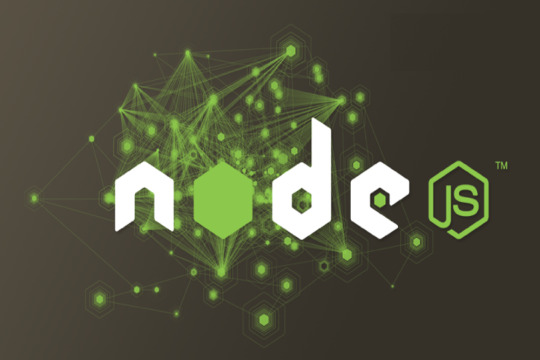
In this article, we will discuss the effective scaling practices of developing Node.js web applications. Most Developers are familiar with the Node.js implementation and we will focus on some advanced tactics to scale per the number of users.
Node.js
Node.js is a JavaScript run-time environment built on Chrome’s V8 JavaScript engine; it implements the reactor pattern, a non-blocking, event-driven I/O paradigm. Node.js is well good for building fast, scalable network applications, as it’s capable of handling a huge number of simultaneous requests with high throughput.
The way to improve the scalability
Before entering into the concept, let’s know what is Scalable? A word Scalable refers to expandable, which means the number of users will access the application from anywhere at the same time. Ensure your application is highly scalable; it can handle a large increase in users, workload or transactions without undue strain.
Regarding increasing the scalable, we are going to explain the options for concurrent users.
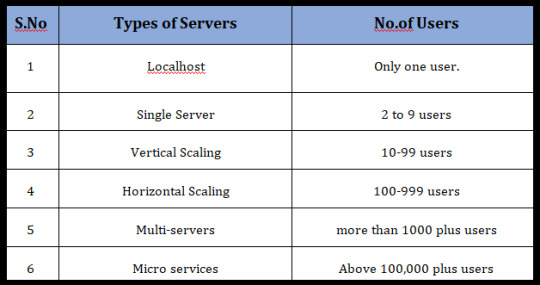
1. Localhost
Any application that runs on a developer machine for development purpose is hosting application locally. Generally, it is for the use of only one user, so there is no need to worry about scaling factor.
2. Single server
A single server system can accommodate around 1 to 9 concurrent users. Assume, your application will be used locally then the deployment will be carried out locally. It’s fine to do in a single server. For hosting the node.js application one can use Nginx as the webserver.
If you are using a single server application for few users well enough. It is simple to implement the single server and very much efficient for a few users. The requirements consist of only one CPU and 1 GB RAM, which is equivalent to web server AWS t2.micro / t2.nano.
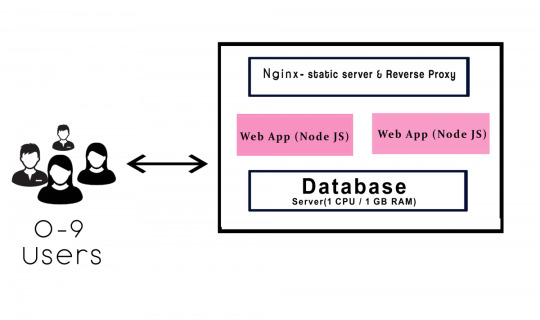
3. Vertical scaling
The term “vertical” states that to manage by adding extra capability or power to a single component. When the server begins to start slower or longer time to execute at the level we will transform to the vertical scaling. In vertical scaling the requirements consist of 4 GB RAM, which is equivalent to web service t2. medium.
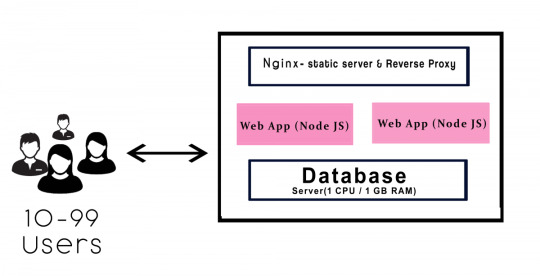
The above diagram explains the workflow in the vertical scaling.
a. It consists of two instances of Node.js which runs to deploy/update within zero downtime.
b. The function of Nginx handles the load balance.
c. If server 1 works to upgrade, then the other server keeps serving the requests. Continue this process until the buffer will get empty.
d. The purpose in Nginx takes into account of all the user requests, It consists of two functions such as a static file server and reverses proxy.
Static — The static files like CSS, JS, Images, this will not disturb the web app.
Reverse Proxy — It will access the request for the needs the application to resolve which redirects it.
4. Horizontal scaling
The Scaling horizontally, which means adding more machines to scale up your pool of resources. This concept will work out in the enterprise from the level of 100 to 1000 employees. Whenever the app responses get slowdown from the database you have to upgrade to 16 GB RAM. Cassandra, MongoDB is suitable for horizontal scaling. It provides for implementing a scale from smaller to a bigger machine.
Companies like Google, Facebook, eBay and Amazon are using horizontal scaling.
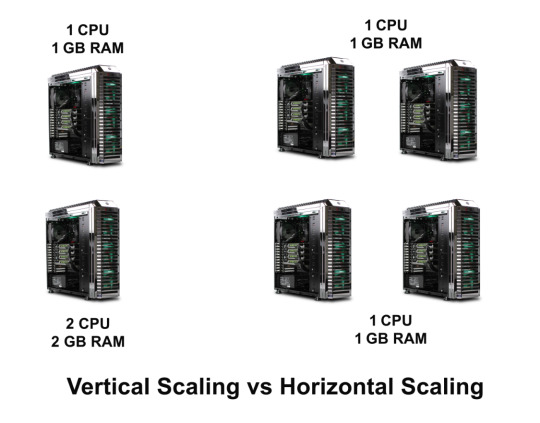
Differences
In horizontal scaling, you can add more machines to scale dynamically. If any system fails, then another system will handle the process. No worry about the process failing. It will bring high I/O concurrency, reducing the load on existing nodes and improve disk capacity.
In vertical scaling, the data resides on a single node, it gets easy to slow down when the load increases. If the system fails to process, then the whole system may get a collapse. Horizontal scaling is little bit cost-effective than the vertical scaling.
5. Multi-servers
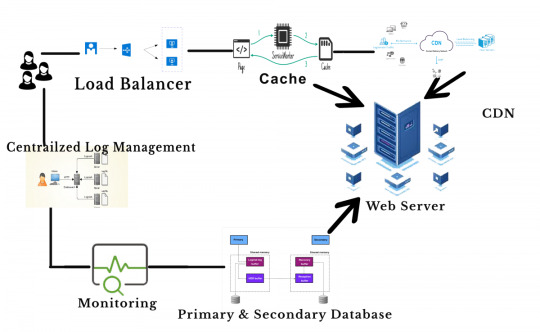
As the business grows, it’s time to add more servers to host the node.js application. The capacity of multi-servers can accommodate above 1000’s of concurrent users. Are you like to transform the previous server to the multi-servers? If Yes, continue with the following steps
1. First, add a load balancer and app units.
2. Set up multiple availability zones (AZ) in a region which one is connected through low latency links.
3. By splitting up the static files for easier maintenance.
4. CDN is one of the servers, which is used to manage files like images, videos, CSS, JS etc.,
Amazon provides load balancing through Elastic Load Balancer (ELB). It is available for the entire availability zone. This service routes to the active host only and can able to manage 1000 instances. By this set up you can use horizontally either vertically.
6. Microservices
Most of the giant companies like Netflix, Uber, Amazon are using microservices. The goals of microservice are to separate the services like search, build, configure and other management functionalities from database instances and deploy them as a separate microservices. Each of these services will take care of their tasks and can communicate with other services via API.
Traditionally we use the monolithic database. In monolithic, we can’t extend our application for several users. All modules are composed together in a single piece. As your business growing up, you have to move on the microservices. This will take to the next level in your production.
Conclusion
Hope this article helped you with scalability issues and helped you understand a bit better of how you can use the available services perfectly.
0 notes
Text
website development services :
Introduction:
Web development services involve the creation of a website as well as the growth and management of the same. These services encompass various tasks, starting from the artistic appearance of a website and ending with the framework that enables the website’s work and stability.
Some of the leading web design companies are SkyWeb Design Technologies that offer a range of business solutions including; e-commerce development services, Content management systems, Custom web applications and services for maintenance and business support. Thus, working with professionals, corporate players can establish sites with high user interaction rates, convenient and safe access, and an improved online presence.

Website development services:
1. Web Design
Web design deals more with the look and feel of a website as well as usability. It includes:
a.Layout Design: Organizing object on a website so that it will be a balanced one that people would want to look at.
b.Color Schemes: Selecting colours that are brand-sensitive and at the same time make sightly better visual pleasure.
c.Typography: Choosing fonts that make the text easily legible and are suitable to the style of the whole project.
D. Imagery: applying images, icons, and graphics that, can make the page more eye-catching and contribute to supplements the content.
2. Front-End Development
Front end also commonly referred to as the client side ensures that the conceptual website design is encoded in the appropriate web browser. It involves
a. HTML (Hypertext Markup Language): These are normally the main frame of any sight, which determines its framework.
b.CSS (Cascading Style Sheets): Designing the web with specific formats and grouping, colors and also the typefaces and the spaces between them.
c.JavaScript: Including interactivity and other converting content as sliders, form inputs and animation.
3. Back-End Development
Back-end development is concerned mainly with data and server operations on the Internet side of the program. It involves:
a.Server Configuration: Provisioning of servers that will act as the online hosts of the website.
b. Database Management: In a way, databases such as MySQL, PostgreSQL, or MongoDB to store and retrieve information.
c. Server-Side Programming: Coding in languages of PHP, python, ruby, or node. js to process the business logic, data, and communications with the front part of the application.
4. Content Management Systems (CMS)
This is due to the fact that a CMS enables non technical individuals to manage the content on a Website with ease. Popular CMS platforms include:
a. WordPress: It is widely used as it is quite flexible and easy to apply in application development.
b. Joomla: It is famous for its stability and numerous settings that allow its users to personalize the application.
c. Drupal: Suitable for large to medium websites that may need enhanced level of modifications.
5. E-commerce Development
E-commerce development involves creating online stores with essential features such as:E-commerce development involves creating online stores with essential features such as:
a. Product Listings: Offering products photos, descriptions, and their prices.
b. Shopping Carts: Enabling the customer to add items that can be purchased.
c. Payment Gateways: Connecting these features such as Paypal, Stripe, or a credit card gateway.
d.Order Management Systems: Responsible for order processing, inventory control and notifiying customers.
6. Responsive Design
Responsive design is the practice of designing the website for proper viewing and usability for every device. Key aspects include:
a. Fluid Grids: Employment of the flexible grids with the ability to adapt to display resolution.
b.Flexible Images: Make images retina and responsive to appropriately fit the devices.
c.Media Queries: Responsive styles which work and apply different style rules depending on the size of the device, its width, height, and the resolution among others.
7. SEO Optimization
Search engine optimization enhances the chances of website ranking on the relevant search engines. Techniques include:
a. Keyword Optimization: Keyword generation and the inclusion of significant keywords in the content.
b.Meta Tags: The following are some of the benefits of updating meta tags to c c c.descriptive ones: When carrying out SEO, it is recommendable to adopt descriptive meta titles and descriptions as this will enhance the chances of the pages being indexed.
d.Link Building: Building the number of backlinks of the given domain, particularly those backlinks that are considered to be of high quality.
e.On-Page SEO: Fixing tiny issues in individual pages, such as improving the page titles and proper image alt tags and linking.
8. Website Maintenance and Support
Maintenance helps in keeping a website up and running and protecting it from any new hacking processes. Services include:
a.Content Updates: Continuing regularly adding, updating the site to make it fresh and relevant for the new users.
b.Bug Fixes: Diagnosing and solving problems that hinder operation of a website. c.Security Updates: Mending and updating of the application to counter some of the threats posed by vulnerabilities.
d. Performance Monitoring: Consistently focusing on the matters of the speed of web-sites and their performance.
9. Custom Web Applications
Custom web applications are developments made for exclusive organization requirements. Examples include:
a. Customer Relationship Management (CRM) Systems: The systems implementing approaches to the handling of customers’ interactions and information.
b. Booking Platforms: Systems for booking or arranging an appointment.
c.Custom Dashboards: Customized tool panels on top of which business metrics and other analytics need be displayed.
10. API Integration
API integration works to link a website with other services in order to improve the given site functionality. Common integrations include:
a.Payment Gateways: The following are the roles of CCPS:
b.Social Media: including feeds of social networks or logins.
c.External Data Sources: Transferring or retrieving information from other sources on the internet or web based services.
11. Performance Optimization
This way it is possible to guarantee optimised performance of a website for a faster loading time. Techniques include:
a.Image Compression: Optimization where an image is made to have lesser megabytes but still have a good resolution.
b.Code Minification: Trimming down code by erasing most of the characters that are not required at all in coding a file.
c.Caching: Caching variables to improve time that is taken to load content which has been frequently accessed.
12. Security Implementation
Security implementation ensures the website and its users are safe from cyber vices. Measures include:
a. SSL Certificates: Protecting the data exchanged between the website’s back-end and the users.
b. Regular Security Audits: Thorough check to be conducted to assess prospects and risks that may be associated with the projects in the future.
c. Best Practices for Data Protection: Policies on creating and using passwords, frequent backups and encrypting programs that are used to code the website.
Top Organizations Engaged in Website Development
In website development, SkyWeb Design Technologies is exceptional compared to other companies. They offer a comprehensive range of services, including:They offer a comprehensive range of services, including:
Custom Web Design and Development: Client-specific designs of the websites.
E-commerce Solutions: Users also want strong and reliable platforms for selling products and services with extra functionalities into their online shopping malls.
CMS Implementation: Incorporating engaging and easy to use content management systems.
Responsive Design: This aspect matters because it checks that the websites are well optimized to operate on all the devices.
SEO Services: Improving website accessibility to the public and its place in search engine results.
Maintenance and Support: Services showing constant actions to update and maintain websites’ status in terms of security from hackers.
SkyWeb Design Technologies is highly qualified with the focus on quality, which puts them in the rank of the best providers of services in building a corporate image.
Tq for visiting us…..
For more information to visit our website: skyweb design technologies
Adress : 15th floor, Manjeera trinity corporation , kukkatpally, HYDERABAD, 500072.
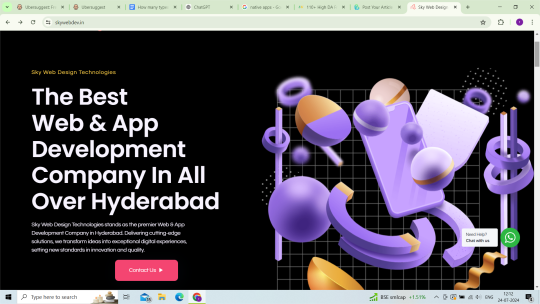
#website development services#web design services#skyweb design technologies#web development services#webdesign services#best website design services
0 notes
Text
Exploring the Best Web3 Development Tools in 2024

We live in a world that is constantly changing with the development of the Internet. As we enter 2024, Web3 technologies are taking the world by storm, creating a new era of decentralized, transparent, and empowered user experiences.
Web3, sometimes referred to as the “decentralized web,” is a new way of building applications based on blockchain, smart contracts, and decentralized protocols. Web3 provides a framework for building applications focused on security, privacy, and peer-to-peer communication.
Web3 developers leverage a variety of innovative tools to build sophisticated Web3 solutions.
These solutions redefine the digital experience, In this blog post, we'll delve into some of the best Web3 development tools driving the evolution of decentralized applications (DApps).
.
1. Ethereum Development Frameworks:
Ethereum is still one of the best platforms for building decentralized applications. Ethereum development frameworks like Truffle and Hearted, as well as Embark, simplify the development process. These frameworks provide the necessary tools to compile smart contracts, test them, and deploy them. These frameworks provide a powerful development environment, allowing developers to write smart contracts efficiently and securely while ensuring smooth integration into the Ethereum blockchain.
.
2. IPFS:
What is IPFS? The Internet Protocol File System (IPFS) is a distributed protocol for storing and sharing content on the Internet. It stores data across a distributed network of nodes, unlike traditional web hosting solutions that store data on a single server. This makes it easier for developers to host static files and websites, as well as decentralized applications.
IPFS is also more resistant to censorship than traditional web hosting solutions.
.
3. Solidity Smart Contract Development Tools:
Solidity is the most popular programming language for building smart contracts on Ethereum. Solidity development tools such as the Remix IDE, the Etherlime IDE, and the Hardhat IDE are designed to make Solidity development easier and faster. These tools provide powerful features like code debugging and gas optimization, as well as automated testing. Solidity allows developers to write smart contracts securely and efficiently, which makes it easier to integrate blockchain logic in decentralized applications.
.
4. Web3.js and Ethers.js:
Ethers.js and Web3.js are two JavaScript libraries that allow you to interact with Ethereum and other blockchains that are compatible with Web3. They provide a wide range of features, such as account administration, transaction signing, smart contract interactions, etc. By embedding these libraries into your applications, you can enable smooth communication with blockchain networks and unlock the potential of decentralized technologies.
.
5. Blockchain Development Platforms:
Blockchain development platforms such as Hyperledger Fabric, Corda, and Binance Smart Chain provide comprehensive tools for building and deploying enterprise-grade blockchain solutions. These platforms offer modular architecture, consensus mechanisms, and interoperable features, catering to a variety of use cases ranging from supply chain management to decentralized finance (DeFi). By leveraging the capabilities of blockchain development platforms, companies can drive innovation and transform their business processes in the Web3 era.
.
Best Web3 Development Company:
As the demand for Web3 solutions continues to soar, businesses and organizations are seeking experienced partners to navigate the complexities of decentralized development. One such standout company leading the charge in Web3 development is Justtry Tech, a premier Web3 Development Company. With a proven track record of delivering cutting-edge blockchain solutions, Justtry Tech combines technical expertise with industry insights to help clients harness the power of decentralization. From concept ideation to product deployment, Justtry Tech offers end-to-end services tailored to the unique needs of each project, ensuring unparalleled quality and innovation in the rapidly evolving Web3 landscape. Whether you're venturing into decentralized finance, non-fungible tokens (NFTs), or decentralized autonomous organizations (DAOs), Justtry Tech is your trusted partner for navigating the exciting world of Web3 development.
.
In conclusion, Web3 development tools are evolving at a rapid pace, allowing developers to create cutting-edge decentralized applications quickly and easily. Whether you’re an experienced blockchain developer or just starting, having the right tools in your toolbox is essential to unlock the full potential of web3 technologies. By adopting cutting-edge tools and frameworks, you can be part of the ongoing revolution of decentralized finance, digital identities, and decentralized governance that will shape the future of the Internet.
#Web3#Web3 Development Company#Web3 Gaming#Web3 Smart Contract#Web3 Development#crypto#blockchain#nft#cryptocurrency#cryptoexchange#bitcoin#etherum#artificial intelligence
0 notes
Text
Nginx
참고: https://smali-kazmi.medium.com/setup-nginx-node-js-on-mac-os-x-b31eda9f7d5d
how to read (pronounce): 엔진 엑스
Nginx currently supports 7 scripting languages: Go, Node.js, Perl, PHP, Python, Ruby, and Java Servlet Containers
(the last is an experimental module)
It enables you to run applications written in different languages on the same server.
how to install: https://dev.to/logrocket/how-to-run-a-node-js-server-with-nginx-588
how to install by M2: 1. homebrew install with terminal commands
/bin/bash -c "$(curl -fsSL https://raw.githubusercontent.com/Homebrew/install/HEAD/install.sh)"
2. PATH for homebrew: (2-lines)
(echo; echo 'eval "$(/opt/homebrew/bin/brew shellenv)"') >> /Users/nika/.zprofile
eval "$(/opt/homebrew/bin/brew shellenv)"
3. run:
To start nginx now and restart at login:
brew services start nginx
Or, if you don't want/need a background service you can just run:
/opt/homebrew/opt/nginx/bin/nginx -g daemon\ off\;
[like this] nginx, "http://localhost:8080/"
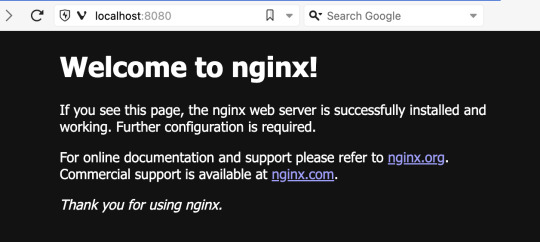
4. stop
nginx -s stop
5. 에러 확인:
nginx -t
nginx: the configuration file /opt/homebrew/etc/nginx/nginx.conf syntax is ok
nginx: configuration file /opt/homebrew/etc/nginx/nginx.conf test is successful
6. 리로드:
nginx -s reload
sudo nano /opt/homebrew/etc/nginx/nginx.conf (after password)
디폴트 구성 바꾸기, (nano: vim, emacs 같은 에디터로 수정하게끔 슈퍼유저 설정 권한을 준다)
나노 명령어:
^G : 도움말 보기
^X : 끝내기
^O : 파일 저장(저장할 파일명 입력, 디폴트는 최초 파일명)
^R : 파일 읽기(현재 파일에 새로운 파일 추가)
^W : 텍스트 검색
^\ : 검색 후 바꾸기
^K : 선택한 문자열 잘라내기
^U : 잘라낸 문자열 붙이기
^J : 양쪽 정렬(한줄로 표시)
^T : 맞춤법 체크
^C : 현재 커서 위치
^- : 입력한 행번호, 열번호로 이동
^A : 현재 행의 처음으로 이동
^E : 현재 행의 마지막으로 이동
Mac 폴더 생성 명령어: mkdir servers
mkdir -p /var/www/sena.com
Mac 파일 생성 명령어: touch ~/servers/examplePage/example.com (~ kite까지 포함)
touch ~/servers/examplePage/app.js
nano 안 쓰고 에러 해결법:
sudo vi 만드려는 파일명 or 저장 할 때
:w !sudo tee % > /dev/null
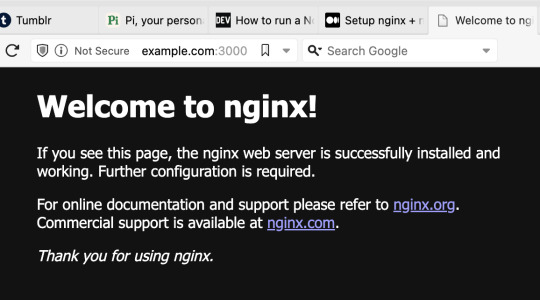
the page eXample:
make folder and "example.com" file
make app.js (javaScript file)
edit /etc/hosts (add 127.0.0.1 example.com)
새 포트 추가하는 법:
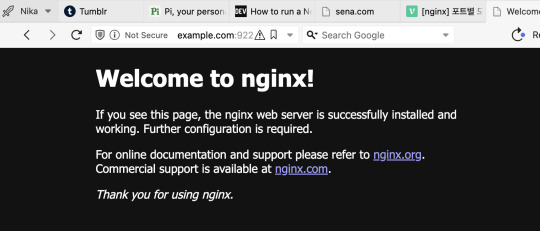
이걸 하고 싶으면 이러면 된다: sudo nano /opt/homebrew/etc/nginx/nginx.conf
링크
0 notes
Text
A Modern Approach to Web Application Development Using MERN Stack

Technology is advancing tremendously quickly right now. With the upgradation of hardware and devices, software technologies are also progressing and replacing outdated ones. Performance is important since a growing number of electronic devices employ real-time features and the Internet. Traditionally, the web development process is supported by technologies with good features but with some limitations that can impact performance. The MERN stack was introduced as a solution to this performance issue and to implement simplicity and uniformity in the development process.
The use of server-rendering technology for web application development was quite popular among developers. While businesses proffered the use of CMS (content management systems) like Drupal and WordPress to build simple websites. The primary advantage of using those CMS was the building speed with minimal coding which was provided by a lot of pre-built templates, themes, and plugins. While it is still preferred by many SMEs, the same properties become a major drawback when enterprises grow and require upgrades or more complex web applications. The pre-built templates proved to be insufficient and as a solution and professionals in the industry begin utilizing the stack of various technologies in web development. Discover more about the MERN stack by reading on or hire the best talent to leverage the MERN stack for your enterprise at WEBSTEP.
What is MERN Stack?
MERN stands for MongoDB, Express, React, and Node. In the stack, MongoDB is the document database, Express(.js) is — Node.js web framework, React(.js) — is a JavaScript library and Node(.js) provides a JS Runtime Environment.
MongoDB: MongoDB is a NoSQL document-oriented database that stores data in a flexible document for scalable high-volume data applications. It has a comparatively faster response and JavaScript interface for testing queries and performing operations with the database.
Express.js: Express is making the development process both simpler and easier. The Node.js framework helps in designing robust APIs with a set of helpful HTTP methods and middleware. It is completely minimalist and has Node features like simplicity, flexibility, scalability and performance.
React: It is a front-end JavaScript library for building user interfaces. One of its major advantages is its capability of handling data-driven interfaces with minimal code.
Node.js: Node is a free open-source web server environment that facilitates the creation of scalable network applications and the execution of JavaScript code outside the browser, on the server.
Advancements in E-commerce Web Application
Over the past few years, e-commerce has grown significantly, providing more advantages and conveniences than traditional enterprises. Additionally, the COVID-19 era has permanently altered how companies interact with customers, enabling enterprises to contact customers faster. MERN stack technologies can contribute to building an operational E-commerce web application and assist SMEs in formulating their business strategy. We have listed some benefits of the MERN stack, to help you understand why it’s the right for development to get desired business outcomes.
Compatibility with a cloud: –E-commerce platforms built with MERN are scalable and highly compatible with the cloud with the use of MongoDB, which itself is compatible with cloud storage. Cloud is everywhere now and it is a remarkable technology that can help businesses succeed.
Security: Even though E-commerce provides more benefits to customers, security is a major concern among SMEs when moving their business online. MERN stack counters this by integrating with secure hosting providers and implementing a secure and theft-proof e-commerce platform.
Unique user experience: If you are looking to reflect the uniqueness of your brand in your e-commerce site, the MERN stack can support that. It allows extensive customizations in the front end to create a striking user interface.
SEO friendly: Enterprises opt for an e-commerce business to increase their reach and market to the target audience. To successfully achieve that, it is important to leverage digital marketing tools and techniques. Websites developed with MERN are optimized and perform well in the matter of page speed, making the website SEO-friendly.
Web application development is no longer the same with the introduction of numerous technologies. Nowadays, there are so many options that it’s common for businesses to be unsure about what’s best for them. A complete online system can be easily built using the MERN stack, especially for e-commerce businesses. When creating a strong and useful website, the MERN stack’s components (Mongo DB, Expresses, ReactJS, and NodeJS) work well together. If you are ready to leverage the capabilities of the MERN, WEBSTEP experts are here to help you get started. Reach out to our consultants to explore possibilities for your business.
Contact Us: Ground Floor, GC 38, GC Block, Sector III, Saltlake, Kolkata — 700106, India.
Visit Our Website: https://www.webstep.in
0 notes
Text
How to Install Node.js on Linux Using Different Methods?
Node JS is an open-source, back-end Javascript code outside a web browser. Here are the steps on how to install Node.js on Linux using various methods. hire node js develoepr
Node.js is a cross-platform that runs on the V8 engine and executes Javascript code outside a web browser. It also allows developers to use Javascript to write command-line tools and run scripts server-side to produce dynamic web page content before the page is sent to the user’s web browser.
.js is a standard filename extension for Javascript code, but Node.js doesn’t refer to a file in this context.
Overview of Node.js
Node.js allows the creation of web servers and networking tools using Javascript and modules that handle various core functionalities. Javascript is the only language that Node.js supports natively. As a result, Node.js applications can be written in Clojure script, Dart, and others. It is officially supported on macOS, Linux, and Microsoft Windows 8.1.
Node.js brings event-driven programming to web servers and allows the development of fast web servers in JavaScript. It connects the ease of a scripting language with the power of Unix network programming. It was built on top of Google’s V8 Javascript engine since it was open-sourced under the BSD license. The Node.js developer community has developed web frameworks to accelerate the development of applications. The frameworks include Socket.IO, Derby, Express.js, Feathers.js, and others.
Modern desktop IEDs provide debugging features for Node.js applications. These IDEs include JetBrains, Microsoft Visual Studio, or TypeScript with Node definitions. It is supported across several cloud hosting programs like Google Cloud Platform, Joyent, and others.
Install NodeJS on Linux Using NVM
This is the best way to install Node.js. NVM is a bash script used to manage multiple Node.js versions. It allows us to install and uninstall Node.js and switch from one version to another. The best thing is we can install any available Node.js version of our choice using NVM.
Install Node.js on Linux using your distribution’s package manager
It is available in the default repositories of most Linux distributions. If you want to have a stable Node.js on your Linux, you can install it using the distribution package manager.
On Arch Linux and its derivatives like Antergos, Manjaro Linux, run the “$ sudo pacman -S nodejs npm” command to install it.
On RHEL, CentOS, you need to enable the EPEL repository first. $ sudo yum install epel-release and then install Node.js using $ sudo yum install nodejs npm command.
For More Info: mobile app development company in india
React Native Development Company
web development
0 notes
Text
Exploring the Fundamentals of Node.js
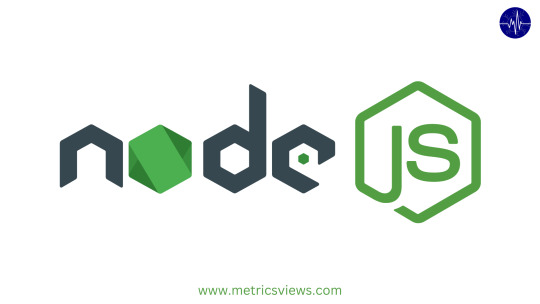
Backend technology and backend languages were covered in our earlier post. We now explore Node.js, the most widely used backend language. We'll walk you through using Node.js to create a basic web server in this post.
Node.js is an effective runtime environment for server-side JavaScript execution. We will explore the fundamentals of Node.js in this beginner-friendly post. We'll go over its installation procedure, essential features, and architecture.
Targeted Audience:
Anybody interested in learning about Node.js, from novices to ambitious developers, should read this article. It requires no prior expertise of server-side coding and only a basic understanding of JavaScript.
Use Cases:
Node.js is a flexible framework that is frequently used to create web servers, scalable network applications, real-time programmes like chat rooms, and more. Web developers can benefit from learning Node.js, especially if they want to expand their knowledge of server-side programming.
Article Composition:
We studied backend technology and backend programming languages in our earlier essay. We will now talk about Node.js, which is the most widely used backend language. This tutorial will walk you through using Node.js to create a basic web server.
Getting Started:
You must have Node.js installed before you can begin constructing a Node.js web server. It should already be operational if you followed our earlier article. If not, you can get it from https://nodejs.org/, the official Node.js website.
Building a Basic Web Server:
Building a web server is quite simple using Node.js. An exemplary Node.js web server is shown here:
const http = require('http');
// Define the hostname and port
const hostname = '127.0.0.1';
const port = 3000;
// Create an HTTP server
const server = http.createServer((req, res) => {
res.statusCode = 200;
res.setHeader('Content-Type', 'text/plain');
res.end('Hello, World!\n');
});
// Listen on the specified hostname and port
server.listen(port, hostname, () => {
console.log(`Server running at http://${hostname}:${port}/`);
});
This code creates an HTTP server that is ready to receive requests, defines a hostname and port, and imports the http module. It says "Hello, World!" in response to a request.
Running Your Server:
Use the node command to launch the code after saving it to a file (such as server.js):
'node server.js'
The IP address of your server is currently http://127.0.0.1:3000/. It is available through your web browser.
We'll look at some of Node.js's more sophisticated features in our upcoming article, such as routing, responding to various kinds of requests, and database interaction. If you build upon this basis, using Node.js to create reliable online applications will come easily to you.
Advantages of Node js:
1)High Performance: JavaScript is natively compiled into native machine code using Google's V8 JavaScript engine, upon which Node.js is based. It is therefore perfect for high-traffic websites and real-time applications because to its remarkable speed and performance.
2)Non-blocking I/O: Node.js employs a non-blocking, event-driven I/O paradigm. This implies that it can manage several connections at once and proceed from one task to the next without waiting for the previous one to complete. This non-blocking feature is essential for applications that need real-time data and high concurrency.
3)Scalability: Developing scalable apps is a good fit for Node.js. Because of its event-driven architecture, which effectively manages many concurrent connections, it's a good option for microservices and applications with demanding scaling requirements.
4)The package manager NPM (Node Package Manager) is included with Node.js and is responsible for hosting a large collection of open-source libraries and modules. This vast network of easily accessible packages streamlines development, saving time and energy.
5)JavaScript All Over: By using Node.js for both the client-side and server-side (front-end) programming languages, programmers may leverage JavaScript across the application stack. Code reusability can be increased and the development process streamlined by unifying the language used.
Limitations of Node js :
1)Single-threaded: Node.js's event-driven, single-threaded approach is useful for effectively managing multiple connections at once, but it isn't appropriate for CPU-bound jobs. CPU-intensive tasks might cause performance bottlenecks by blocking the event loop.
2)Callback Hell: When writing asynchronous code in Node.js, it's common to encounter callback hell, which makes it difficult to read and manage several nested callbacks. This can make it difficult to maintain the code.
3)Absence of Mature Libraries: Although Node.js has a robust library ecosystem, certain sectors, particularly those conventionally linked with alternative programming languages (e.g., scientific computing), might possess a smaller number of well-established libraries.
4)Restricted Support for Multi-core Processing: Due to its single-threaded architecture, Node.js is unable to fully utilise multi-core CPUs. In order to take advantage of multi-core capabilities, developers frequently need to employ extra tools and strategies.
5)Less Safe for Tasks Requiring a CPU: CPU-bound operations are not well suited for Node.js. A CPU-intensive task may cause the event loop to become blocked, which could pose a serious security risk by rendering the server unavailable to incoming requests.
We are grateful that you are interested in learning more about Node.js. Do not hesitate to contact us with any queries or recommendations.
With Node.js, you can do much more than just build a basic web server. As we work through these tutorials, you'll learn more about Node.js and develop your skills in creating server-side apps. Watch this space for more informative insights and fascinating Node.js lessons.
Credit – Kashif Patel (Backend Lead)
MetricsViews Pvt. Ltd.
MetricsViews specializes in building a solid DevOps strategy with cloud-native including AWS, GCP, Azure, Salesforce, and many more. We excel in microservice adoption, CI/CD, Orchestration, and Provisioning of Infrastructure - with Smart DevOps tools like Terraform, and CloudFormation on the cloud.
www.metricsviews.com
0 notes
Text
Full Stack Developer Course Kochi – Become a Versatile Developer with Techmindz
In today’s digital age, full-stack development has become one of the most sought-after skills in the tech industry. Full-stack developers are capable of building both the front-end and back-end of web applications, making them invaluable in today’s fast-paced job market. If you're looking for a full stack developer course in Kochi, Techmindz offers comprehensive, hands-on training that will equip you with the skills to succeed in this dynamic field.
Why Become a Full Stack Developer?
Full-stack developers are versatile professionals who are proficient in both front-end (UI/UX design) and back-end (server, database, and application logic) technologies. They are able to build and deploy complete web applications, making them an essential part of modern development teams. Learning full-stack development opens up a world of job opportunities, from web development to enterprise application design.
Why Techmindz Offers the Best Full Stack Developer Course in Kochi
At Techmindz, we understand the importance of practical, industry-oriented training. Here’s why our full stack developer course in Kochi is the best choice for aspiring developers:
1. Comprehensive and Updated Curriculum
Our full-stack developer program covers the entire spectrum of modern web development, including:
Front-End Technologies: HTML, CSS, JavaScript, React.js, and Angular
Back-End Technologies: Node.js, Express.js, and database management (MongoDB, SQL)
Version Control Systems: Git and GitHub
Web Services: RESTful APIs and WebSockets
Deployment and Hosting: Deploying applications using cloud services like AWS or Heroku
Security Best Practices for developing secure applications
2. Project-Based Learning
At Techmindz, we believe in learning by doing. Our students work on live projects that simulate real-world scenarios, allowing them to build a portfolio that showcases their abilities. From simple web apps to complex enterprise-level solutions, students gain valuable experience in creating scalable and functional applications.
3. Experienced Trainers with Industry Expertise
Our instructors are industry professionals with years of experience in full-stack development. They bring valuable insights and best practices to the classroom, helping students not only understand the technologies but also learn how to apply them effectively in the workplace.
4. Placement Support and Career Guidance
We provide career support, including resume building, mock interviews, and direct job placement assistance. Techmindz has strong connections with IT companies in Kochi and beyond, making it easier for graduates to land positions as full-stack developers, web developers, or software engineers.
5. Flexible Learning Options
Whether you prefer in-person classes at our Kochi campus or online learning, Techmindz offers flexible course options to suit your schedule. We understand that every student’s needs are different, and we strive to provide a learning environment that works for you.
Conclusion
If you're looking to fast-track your career in web development, Techmindz’s full stack developer course in Kochi is the perfect choice. Our comprehensive curriculum, hands-on training, and strong placement support will help you become a highly skilled developer ready for today’s tech industry.
0 notes
Text
How to Hire the Right node js Developer on Contract: Key Points to Consider
Hiring a skilled, Node.js Developer might be challenging, but it's possible with the correct approach and some planning. We have covered all the bases in this post to ensure a smooth and productive recruiting process for Node JS engineers. So, let us figure out how to round out your team with competent programmers who are a good fit for your project.
For What Reasons Is Investing In A Node.Js Developer The Right Move For Your Company?
Developers skilled in Node.js are essential to the improvement of web apps in terms of both performance and responsiveness. Experienced Node.js developers are in very high demand as organisations strive to expand their online presence. Some outstanding arguments in favour of hire node js developer for your next project are as follows. In-Depth Knowledge Your project is safe in their hands because of their extensive understanding of the ecology. By utilising their abilities, firms may anticipate receiving first-rate web apps crafted to meet the needs of their company and its customers. Incorporating Minimalism Node.js's elegance comes from its ease of use. Hiring experts in this field guarantees a trouble-free development experience. Node.js is an intriguing option for businesses searching for robust but cost-effective online solutions because of its low price and high performance. Web Application Development in Real Time Building real-time online applications like chat programs, gaming servers, or dynamic news feeds is where Node.js excels. These applications are lightweight, practical, and able to handle several simultaneous connections with excellent throughput because of their non-blocking I/O operations. You can leverage this capacity to build dynamic, real-time apps that improve user engagement and provide a contemporary online experience if you have a Node.js developer on staff. Outsource Your Search For A Node.Js Developer In terms of recruiting strategies, outsourcing to an agency may save you both money and time. You may outsource your Node.js development tasks to a proven company using this method. These organisations have teams that have previously collaborated on projects. This saves you time and money by giving you access to a group of highly skilled experts who can do a variety of tasks (design, project management, engineering, etc.).
The contracted firm will tailor a solution based on the details of your project. Each member of the team will sign a separate NDA. Outsourcing organisations may need to learn the ins and outs of their business, which is a drawback. They might be located in a different time zone, adding another factor to consider.
Professional Node JS Developers Make Hosting Easy and Convenient In order to reduce wait times for users of PaaS (platform-as-a-service), this platform regularly adds new features and functionality. This is one of the main draws of Node JS for web development among open-source software development organizations. Effortless Sharing Many web development firms like this Node JS framework over others due in large part to the NPM's (Node Package Manager) ease of sharing. Node JS makes it easy to swiftly distribute data, which speeds up the whole development process. As an example, many Node JS developers use NPM to collaborate on projects by exchanging code and other assets. Additionally, NPM enables simple code management and deployment.
Cost-Effective Node JS reduces the amount of processing power needed to host websites. The multitasking capabilities of Node JS-based programs are well documented. Due to its event-driven and single-threaded architecture, it can handle several requests at once without taxing RAM.
Conclusion
Location, project complexity, developer experience and skill level, and the development firm's approach to hiring all play a role in determining the compensation range for Node.js developers.
0 notes
Text
ASPX, PHP, Node, CGI-BIN, server side HTML
A quick overview for the novices: server-side scripting isn't new, and there's plenty of ways to avoid browser side scripting, and plenty of solutions that "complete" HTML as a dynamic script.
These scripts do work on the server, however, the browser has to wait for every transaction between whatever you create dynamically. It makes a new http call every transaction.
They don't really help the device do what browser side js can do, because it has to download the exchange every time. Plus, the cost to the host to support it is increased exponentially for every user that you need to support simultaneously.
What they are bad at: doing things on the user side like animations, interactions, or anything that doesn't explicitly require talking to the server about.
What they are good at: anything that requires server side interactions: storing information that needs to be secure, talking with other users, buying things.
If you play a lot switch games, the differences between online play between super smash Bros and Mario kart Best demonstrate the differences.
Mario Kart network interactions are more reliant on user side tweening, which is why there's a lot less frame interruption and why it feels *smoother*.
Super Smash Bros however, needs frame specific interactions on the server (or host side) gameplay. This uses server validation to ensure the player's frames are more or less lined up. And that's why if your connection is unstable, it can feel and look very choppy.
One relys more on user side scripting, one relys more on server side scripting.
This actually happens quite a bit in mobile gaming too. The menus rely heavily on server-side scripting, and it makes them feel heavy, and it's why you wait 3-minutes before the game will let you do anything.
Mobile gaming relies on the RESTful API, which is the standard HTTP API.
They do this mostly as a security protocol to prohibit hacking and cheating (it's heavier the more micro-transactions that they include)
But since they rely so heavily on server-side scripting, the user-experience is heavily impacted.
It's why balancing between browser and server is incredibly important.
One last thing, many coding standards that have been developed over the years have thumped the importance of server-side scripting, this is kind of an outdated policy.
The reason they do that is so you don't have to guess at what kind of device the user is using. So if you just make all the *hard work* server side, then the user won't be impacted.
However, when you see this used in games created in Unity or Godot, and played on Android and Apple devices, you're forgetting that you're already using the user-side scripting to just... play the game.
Both stores includes a version and device check for certain games (which is funny when you have a device that should support the app but the appstore says you can't)
If a user is using a device incapable of using CSS or JS, for whatever reason, that's one thing, you can make a simple page to cover that need. But most everybody else has a smartphone that's been updated in the last decade or so.
0 notes
Text
Web Scraping Using Node Js
Web scraping using node js is an automated technique for gathering huge amounts of data from websites. The majority of this data is unstructured in HTML format and is transformed into structured data in a spreadsheet or database so that it can be used in a variety of applications in JSON format.
Web scraping is a method for gathering data from web pages in a variety of ways. These include using online tools, certain APIs, or even creating your own web scraping programmes from scratch. You can use APIs to access the structured data on numerous sizable websites, including Google, Twitter, Facebook, StackOverflow, etc.
The scraper and the crawler are the two tools needed for web scraping.
The crawler is an artificially intelligent machine that searches the internet for the required data by clicking on links.
A scraper is a particular tool created to extract data from a website. Depending on the scale and difficulty of the project, the scraper's architecture may change dramatically to extract data precisely and effectively.
Different types of web scrapers
There are several types of web scrapers, each with its own approach to extracting data from websites. Here are some of the most common types:
Self-built web scrapers: Self-built web scrapers are customized tools created by developers using programming languages such as Python or JavaScript to extract specific data from websites. They can handle complex web scraping tasks and save data in a structured format. They are used for applications like market research, data mining, lead generation, and price monitoring.
Browser extensions web scrapers: These are web scrapers that are installed as browser extensions and can extract data from websites directly from within the browser.
Cloud web scrapers: Cloud web scrapers are web scraping tools that are hosted on cloud servers, allowing users to access and run them from anywhere. They can handle large-scale web scraping tasks and provide scalable computing resources for data processing. Cloud web scrapers can be configured to run automatically and continuously, making them ideal for real-time data monitoring and analysis.
Local web scrapers: Local web scrapers are web scraping tools that are installed and run on a user's local machine. They are ideal for smaller-scale web scraping tasks and provide greater control over the scraping process. Local web scrapers can be programmed to handle more complex scraping tasks and can be customized to suit the user's specific needs.
Why are scrapers mainly used?
Scrapers are mainly used for automated data collection and extraction from websites or other online sources. There are several reasons why scrapers are mainly used for:
Price monitoring:Price monitoring is the practice of regularly tracking and analyzing the prices of products or services offered by competitors or in the market, with the aim of making informed pricing decisions. It involves collecting data on pricing trends and patterns, as well as identifying opportunities for optimization and price adjustments. Price monitoring can help businesses stay competitive, increase sales, and improve profitability.
Market research:Market research is the process of gathering and analyzing data on consumers, competitors, and market trends to inform business decisions. It involves collecting and interpreting data on customer preferences, behavior, and buying patterns, as well as assessing the market size, growth potential, and trends. Market research can help businesses identify opportunities, make informed decisions, and stay competitive.
News Monitoring:News monitoring is the process of tracking news sources for relevant and timely information. It involves collecting, analyzing, and disseminating news and media content to provide insights for decision-making, risk management, and strategic planning. News monitoring can be done manually or with the help of technology and software tools.
Email marketing:Email marketing is a digital marketing strategy that involves sending promotional messages to a group of people via email. Its goal is to build brand awareness, increase sales, and maintain customer loyalty. It can be an effective way to communicate with customers and build relationships with them.
Sentiment analysis:Sentiment analysis is the process of using natural language processing and machine learning techniques to identify and extract subjective information from text. It aims to determine the overall emotional tone of a piece of text, whether positive, negative, or neutral. It is commonly used in social media monitoring, customer service, and market research.
How to scrape the web
Web scraping is the process of extracting data from websites automatically using software tools. The process involves sending a web request to the website and then parsing the HTML response to extract the data.
There are several ways to scrape the web, but here are some general steps to follow:
Identify the target website.
Gather the URLs of the pages from which you wish to pull data.
Send a request to these URLs to obtain the page's HTML.
To locate the data in the HTML, use locators.
Save the data in a structured format, such as a JSON or CSV file.
Examples:-
SEO marketers are the group most likely to be interested in Google searches. They scrape Google search results to compile keyword lists and gather TDK (short for Title, Description, and Keywords: metadata of a web page that shows in the result list and greatly influences the click-through rate) information for SEO optimization strategies.
Another example:- The customer is an eBay seller and diligently scraps data from eBay and other e-commerce marketplaces regularly, building up his own database across time for in-depth market research.
It is not a surprise that Amazon is the most scraped website. Given its vast market position in the e-commerce industry, Amazon's data is the most representative of all market research. It has the largest database.
Two best tools for eCommerce Scraping Without Coding
Octoparse:Octoparse is a web scraping tool that allows users to extract data from websites using a user-friendly graphical interface without the need for coding or programming skills.
Parsehub:Parsehub is a web scraping tool that allows users to extract data from websites using a user-friendly interface and provides various features such as scheduling and integration with other tools. It also offers advanced features such as JavaScript rendering and pagination handling.
Web scraping best practices that you should be aware of are:
1. Continuously parse & verify extracted data
Data conversion, also known as data parsing, is the process of converting data from one format to another, such as from HTML to JSON, CSV, or any other format required. Data extraction from web sources must be followed by parsing. This makes it simpler for developers and data scientists to process and use the gathered data.
To make sure the crawler and parser are operating properly, manually check parsed data at regular intervals.
2. Make the appropriate tool selection for your web scraping project
Select the website from which you wish to get data.
Check the source code of the webpage to see the page elements and look for the data you wish to extract.
Write the programme.
The code must be executed to send a connection request to the destination website.
Keep the extracted data in the format you want for further analysis.
Using a pre-built web scraper
There are many open-source and low/no-code pre-built web scrapers available.
3. Check out the website to see if it supports an API
To check if a website supports an API, you can follow these steps:
Look for a section on the website labeled "API" or "Developers". This section may be located in the footer or header of the website.
If you cannot find a dedicated section for the API, try searching for keywords such as "API documentation" or "API integration" in the website's search bar.
If you still cannot find information about the API, you can contact the website's support team or customer service to inquire about API availability.
If the website offers an API, look for information on how to access it, such as authentication requirements, API endpoints, and data formats.
Review any API terms of use or documentation to ensure that your intended use of the API complies with their policies and guidelines.
4. Use a headless browser
For example- puppeteer
Web crawling (also known as web scraping or screen scraping) is broadly applied in many fields today. Before a web crawler tool becomes public, it is the magic word for people with no programming skills.
People are continually unable to enter the big data door due to its high threshold. An automated device called a web scraping tool acts as a link between people everywhere and the big enigmatic data.
It stops repetitive tasks like copying and pasting.t
It organizes the retrieved data into well-structured formats, such as Excel, HTML, and CSV, among others.
It saves you time and money because you don’t have to get a professional data analyst.
It is the solution for many people who lack technological abilities, including marketers, dealers, journalists, YouTubers, academics, and many more.
Puppeteer
A Node.js library called Puppeteer offers a high-level API for managing Chrome/Chromium via the DevTools Protocol.
Puppeteer operates in headless mode by default, but it may be set up to run in full (non-headless) Chrome/Chromium.
Note: Headless means a browser without a user interface or “head.” Therefore, the GUI is concealed when the browser is headless. However, the programme will be executed at the backend.
Puppeteer is a Node.js package or module that gives you the ability to perform a variety of web operations automatically, including opening pages, surfing across websites, analyzing javascript, and much more. Chrome and Node.js make it function flawlessly.
A puppeteer can perform the majority of tasks that you may perform manually in the browser!
Here are a few examples to get you started:
Create PDFs and screenshots of the pages.
Crawl a SPA (Single-Page Application) and generate pre-rendered content (i.e. "SSR" (Server-Side Rendering)).
Automate form submission, UI testing, keyboard input, etc.
Develop an automated testing environment utilizing the most recent JavaScript and browser capabilities.
Capture a timeline trace of your website to help diagnose performance issues.
Test Chrome Extensions.
Cheerio
Cheerio is a tool (node package) that is widely used for parsing HTML and XML in Node.
It is a quick, adaptable & lean implementation of core jQuery designed specifically for the server.
Cheerio goes considerably more quickly than Puppeteer.
Difference between Cheerio and Puppeteer
Cheerio is merely a DOM parser that helps in the exploration of unprocessed HTML and XML data. It does not execute any Javascript on the page.
Puppeteer operates a complete browser, runs all Javascript, and handles all XHR requests.
Note: XHR provides the ability to send network requests between the browser and a server.
Conclusion
In conclusion, Node.js empowers programmers in web development to create robust web scrapers for efficient data extraction. Node.js's powerful features and libraries streamline the process of building effective web scrapers. However, it is essential to prioritize legal and ethical considerations when engaging in Node.js web development for web scraping to ensure responsible data extraction practices.
0 notes
Text
How Node JS Bring Success to Your Online Business?
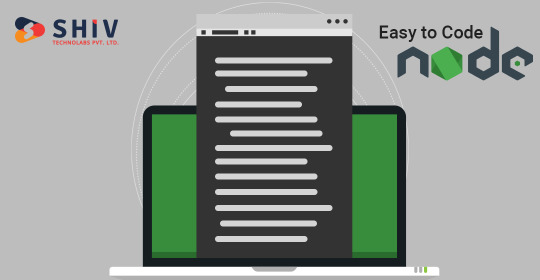
Node.js is one of the best JavaScript platform which is built on Chrome’s V8 JavaScript engine. Node.js development is one of the powerful, efficient, fast, & scalable web server. It is developed to use non-blocking, event-driven I/O to remain lightweight & efficient in the face of data-intensive real time apps that runs across multiple devices.
Today, many top app development companies use it for various security benefits such as high performance, cloud-enabled technology, cheap hosting services, MVP delivery, easy execution & installation, lightweight Node Js Development Services.
Top Benefits of NodeJS for Your Online Business
1. It’s Easy to Code
Node.js code is easy to learn and write and web developers can easily write code in JavaScript for both the server & client. JavaScript makes it convenient for transferring data between the client & the server that works simultaneously.
2. No Learning Curves Involved
As we have discussed above that it’s easy to learn node.js and you don’t have to go through the complex syntax learning & grasping procedures since the node is based on JavaScript.
Node.js developers will find it flexible to learn, code, develop, & deploy scalable node apps on multiple platforms such as Windows & UNIX. Even it’s easy to learn for beginners as well and can easily develop some robust applications.
3. Best for Developing Real-Time Web Apps
Node.js helps you to build real-time web applications at a light speed for making simple blog sites in Chat apps, gaming apps. The event-driven architecture serves both client and server-side codes written in JavaScript.
4. Allow Data Streaming
Web developers know that HTTP request & response are two separate events where developers can take benefits of data streams such as processing files at the time of loading & creation of the attributes, it also reduces the duration of the data transmission process.
5. NPM Enterprise
NPM enables programmers to install, update, & utilize smaller modules of open-source software packages. It makes the process much easier without any complexity for developers to build apps from scratch.
Developers can avoid writing complex coding layers by simply twisting the code lines as per their requirements. The major benefit is that a plethora of Node.js libraries & apps are published on npm, and several are added every day.
6. Hosting
The demand for web hosting is increased and Node.js is one of the most popular and in-demand platforms from the past few years. PaaS service providers like Heroku and Modulus are allowing the deployment of node.js without any problem for your web hosting needs.
7. Cross-Platform Ensures Flexibility
As Node.js is a cross-platform JavaScript platform, it offers the maximum flexibility in terms of hosting it on any server. Since Node application can be implemented on multiple platforms and that gives multiple options to the developers.
8. Useful for Clients
Node.js has the support of a huge open source community that delivers outstanding modules that work everywhere such as Socket.io. It maintains the constant communication between the client & the server and allows them to send real-time updates to each other.
9. Proxy Server
Node provides the best solution for the proxy server and it also works as a Proxy to the firms that do not have the proper infrastructure for proxy needs.
10. Benefits of Caching
As Node.js provides the open-source platform, developers can enjoy the benefit of caching single modules as well. When you request for the first modules, it will get cached automatically on the app's memory.
It enables developers to load web pages faster as they don’t have to re-execute the codes. Also, users can navigate through these applications swiftly because of Node.js high responding speed.
Wrapping-up:
From the above discussion, it’s clear that Node.js is much popular among startups and provides you many more benefits that is the reason why big giants like PayPal, Netflix, Microdot, and eBay are using Node as a feature-rich app development framework today. Shiv Technolabs Pvt. Ltd. is the best NodeJS Development Company & our dedicated Node.js developers are technology-conscious and can be a helping hand for your several projects of web Development.
1 note
·
View note
Text
The Evolution and Importance of Web Application Development

Web application development began shortly after the introduction of the internet. When the web apps were created at the beginning, they were static. Over time, audio, videos, and images were added. With the advent of Ajax into the web world in 2005, developers were able to build a faster, more interactive, and improved website.
Microsoft Office, Facebook, and Basecamp are examples of web app development. These programs and suites are interactive, integrated with advanced features and tools, and are easy to use as web apps and native mobile apps. As part of the development process, these apps are hosted by a third party on servers, and server-side and client-side programming is used. With the use of programming and other unique technologies, developers can develop applications that can be accessed through the internet without the need of downloading every single time.
The Intricate Process of App Development

The entire process that is involved in app development is intricate and time intensive. A developer or a team of developers is responsible for a variety of steps that have to be followed for building a functional and user-friendly application. Let's look at the process now.
The inception of the idea
This is the first step towards web app development. Here, the developers collect data required for the application, determine the use of the app and what problems will it need to solve, basically the role or the goal of the web app. A well-drawn blueprint or idea is better for the developers to come up with the best possible features and skills to be inducted in the application.
That is why is the first and most important part in the development process followed by the main step, which is prototype development.
Prototype development
Here is where all the ideas, imagination and vision comes to life. The first step is to create a prototype to present their vision to the audience. The response from the audience and targeted users comes in the form of feedback or reviews which form the base for designing and development of the app which will incorporate the upgrades to suit the users. Mind you, these upgrades, technologies are added on the bases of the response received from the users.
The next step is the construction of the app. The developers are required to use appropriate front end and back end programming to maintain the functionality and appearance of the app. Frameworks like JavaScript, Angular JS, Node JS and others are deployed to create a sturdy and easy to use apps. Tthey also create user interaction between the server and user.
For the database, it is important to select the ideal data types that will work well with the type of app that is being developed. It increases the efficiency and space required for database storage in the application.
Testing
Testing is a crucial step in web app development. The team checks for various standards such as security,performance, versatility, compatibility, etc. While it helps in making sure that the app is meeting all the parameters, it is also helpful in assisting the professional in adding more upgrades and useful features to make the app more functional and efficient.
Launch and maintenance
After going through all the steps, it is finally time to launch the app in the market. But the work doesn’t stop because you have to consciously work on maintaining the working of the app. Constantly adding something new to it, and updating the installed feature enhances the capacity and efficiency of the app which is a must in today’s time and with constant technological evolutions.
How is Web Application Development Necessary for Business?

It is absolutely clear to all that web apps are an absolute need in the financial sector today. Not only from a business perspective but from the customer’s point of view as well. It is important to be aware of the various roles that web apps play in this industry.
They play an important role in terms of connecting the business with its customers. Since apps are run on the internet, there is no need for any download which is excellent for the customers since they can directly access the apps without going through any long process. This ensures high traffic and gives a boost to the business, all the while providing excellent customer service. These apps are constantly being tested and new versions are launched frequently. This enhances their working capacity and users are able to get their tasks done quickly with much more precision.
Various other factors such as 24/7 availability, high security measures, cross-platform access, etc are all essential for a business to run smoothly and compete successfully in today's highly competitive marketplace.
Conclusion
Today, these are a variety of business strategies being deployed by the cooperations to remain in the marketplace, among them web app development is integral to main connection between a company and its most important assests, that is the users. App development focuses upon the communicating the ideals and ambitions of a company to its users. That is why it is important to invest in app development to insure quality and customer satisfaction. After all, web apps are the face of the financial industry today.
0 notes